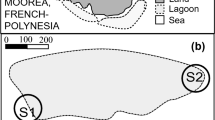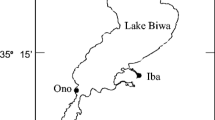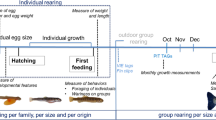Summary
We demonstrate here the existence of a range of size-independent reproductive tactics in teleostean fish involving the allocation of a size-dependent reproductive effort between fecundity and egg size. Despite considerable evidence that larger eggs and the larvae hatching from them are more likely to survive than smaller ones, we found no evidence of evolutionary trends towards greater egg sizes. Fish with pelagic eggs tend to spawn many, and therefore small, eggs, whereas demersal spawners tend to produce large, and therefore few, eggs. Maximizing egg number should increase the number of eggs hatching in suitable locations in the patchy pelagic environment and, hence, increase the reproductive success of pelagic spawners. On the other hand, the reproductive success of demersal spawners, which reduce the variance in growing conditions experienced by the off spring, should be more dependent on the survival of the individual larvae, which increases as egg size increases.
Similar content being viewed by others
References
Balon EK (1984) Patterns in the evolution of reproductive styles in fishes. pp. 35–54. In G.W. Potts, and R.J. Wooton (Eds.) Fish reproduction: strategies and tactics. Academic
Blueweiss L, Fox H, Kudzma V, Nakashima D, Peters RH, Sams S (1978) Relationships between body size and some life history parameters. Oecologia 37:257–272
Capineri JL (1979) Quantitative variation in plants and insects: effect of propagule size on ecological plasticity. Am Nat 114:350–361
Dando PR (1984) Reproduction in estuarine fish. In: Potts GW, Wooton RJ (eds) Fish reproduction: strategies and tactics. Academic Press, Oxford, pp 155–170
Fortier L, Leggett WC (1985) A drift study of larval fish survival. Mar Ecol Prog Ser 25:245–257
Hislop JRG (1984) A comparison of the reproductive tactics and strategies of cod, haddock, whiting and Norway pout in the Northern Sea. In: Potts GW, Wooton RJ (eds) Fish reproduction: strategies and tactics. Academic Press, Oxford, pp 311–330
McGurk MD (1986) Natural mortality of marine pelagic fish eggs and larvae: role of spatial patchiness. Mar Ecol Prog Ser 34:227–242
Miller PJ (1984) The tokology of gobioid fishes. In: Potts GW, Wooton RJ (eds) Fish reproduction: strategies and tactics. Academic Press, Oxford, pp 119–154
Pauly D, Pullin RSV (1988) Hatching time in spherical, pelagic, marine fish eggs in response to temperature and egg size. Env Biol Fish 22:261–271
Peters RH (1983) The ecological implications of body size. Cambridge University Press, Cambridge
Potts GW (1984) Parental behavior in temperate marine teleosts with special reference to the development of nest structures. In: Potts GW, Wooton RJ (eds) Fish reproduction: strategies and tactics. Academic Press, Oxford, pp 223–244
Ware DM (1975) Relation between egg size, growth, and natural mortality of larval fish. J Fish Res Board Can 32:2503–2512
Wooton RJ (1984) Introduction: Strategies and tactics in fish reproduction. In: Potts GW, Wooton RJ (eds) Fish reproduction: strategies and tactics. Academic Press, Oxford, pp 1–12
Author information
Authors and Affiliations
Rights and permissions
About this article
Cite this article
Duarte, C.M., Alcaraz, M. To produce many small or few large eggs: a size-independent reproductive tactic of fish. Oecologia 80, 401–404 (1989). https://doi.org/10.1007/BF00379043
Received:
Issue Date:
DOI: https://doi.org/10.1007/BF00379043




